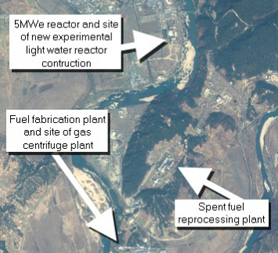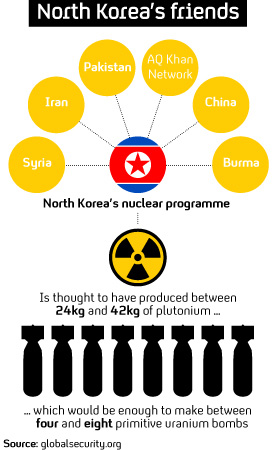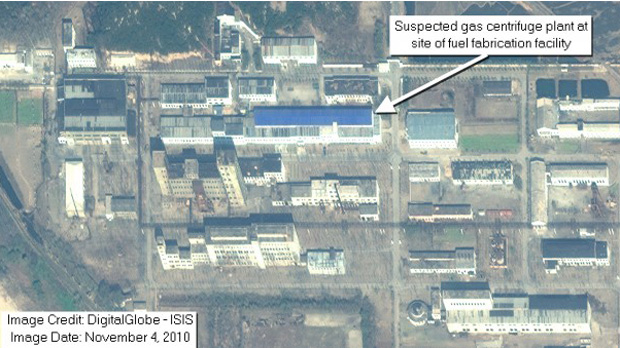The North Korea nuclear question
Today’s exchange of fire highlights increasingly sour relations between North and South Korea but of more concern is the possible size and viability of North Korea’s nuclear arsenal.

There has been increased speculation about North Korea‘s nuclear ambitions over the past few days after it emerged that Professor Siegfried Hecker and colleagues from Stanford University gained rare access to a light water nuclear reactor at the Yongbyon nuclear site, 60 miles north of the capital Pyongyang.
In a report published on the Stanford University website, Prof Hecker noted: “On November 12, during my most recent visit to the Yongbyon Nuclear Complex with Stanford University colleagues John W. Lewis and Robert Carlin, we were shown a 25 to 30 megawatt-electric (MWe) experimental light-water reactor (LWR) in the early stages of construction.
“It is North Korea’s first attempt at LWR technology and we were told it is proceeding with strictly indigenous resources and talent. The target date for operation was said to be 2012, which appears much too optimistic.”
“What is surprising is the sheer scale of the operation” Alex Neill, head of the Asia security programme at RUSI
North Korea has in the past denied having uranium enrichment programmes but Prof Hecker found not only that the North Koreans have such a programme but that their technology for doing so is “ultra-modern and clean”.
Prof Hecker wrote that the facilities appeared to be designed for civilian nuclear power generation but added that the second facility he was shown, “could be readily converted to produce highly-enriched uranium (HEU) bomb fuel” with the light water reactor having potential to run in a mode to produce weapons grade plutonium, though not of as high a grade as would be possible with existing facilities.
The facility the team was shown consisted of 2,000 centrifuges which the North Koreans say are already producing low grade uranium for civilian purposes.

Weapons
Although the North Koreans maintain their nuclear programme is designed purely to generate electricity for the isolated state, there are strong concerns that the technology could be used to create weapons grade nuclear material.
It has been extremely difficult to accurately assess the size of North Korea’s nuclear arsenal, especially since its uranium programme, although long suspected, has only just been confirmed.
Following his recent visit, Professor Hecker believes the country has frozen its plutonium enrichment programme, meaning it is possible that earlier estimates that North Korea has generated sufficient plutonium for four to eight primitive (basic) nuclear weapons is still current.
Developing uranium however would give North Korea the potential to create more powerful and efficient weapons. The scale of the technology seen by the Stanford party if viable, could mean that the country has the capability to create 30 – 40kg of uranium per year which experts say could be enough for one or two weapons.
The crucial issue however is that along with a viable payload, North Korea must also develop a viable vehicle for that which it does not appear to have done thus far.
Its domestically developed Taepodong missile has not been successfully used and recent test firings saw the warhead fail to send its payload into orbit, something the North Koreans dispute.
Our International Editor, Lindsey Hilsum, writes: An interesting article in today's Asia Times may throw some light on today's incident in the Yellow Sea off the two Koreas.
The author, Kim Myong-Chol, who lives in Tokyo but is described as "an unofficial spokesman" for the North Korean government, is talking up the role of Kim Jong-un, son and heir apparent to President Kim Jong-il.
"The young general has proved in the eyes of the Workers Party of Korea and the military that he is decisive and ready to risk war at anytime with the US and Japan over the slightest infringement of the sovereignty and independence of North Korea," he writes.
He says that the 27-year-old "has authored papers on nuclear war strategy, missiles and long-range weapons for use in ground warfare and air-defence, winning the acclaim of military leaders."
Read Lindsey's World News blog North Korea: Is the heir apparent influencing policy?

Another arms race?
Alex Neill, head of the Asia security programme at the Royal United Services Institute (RUSI) said the disclosure of the new nuclear facilities will ring alarm bells for the US and the International Atomic Energy Agency (IAEA).
“What is surprising is the sheer scale of the operation. The problem is now that the US has to deal with both the exchange of fire and the news about North Korea’s nuclear capability,” he said.
And he believes that North Korea’s involvement with other states’ weapons programmes means there is the real potential for an arms race in one of the world’s most politically-volatile areas, the middle-east.
“I think the Iranians are as determined to pursue a nuclear capability as North Korea. Saudi Arabia could easily obtain nuclear weapons, Egypt wants a nuclear capability as does Syria.
“America’s ‘axis of evil’ rhetoric revealed the true suspicions of the US establishment and this is something which I think is still there in the Obama administration.”